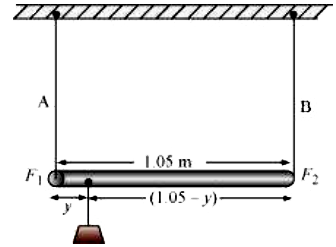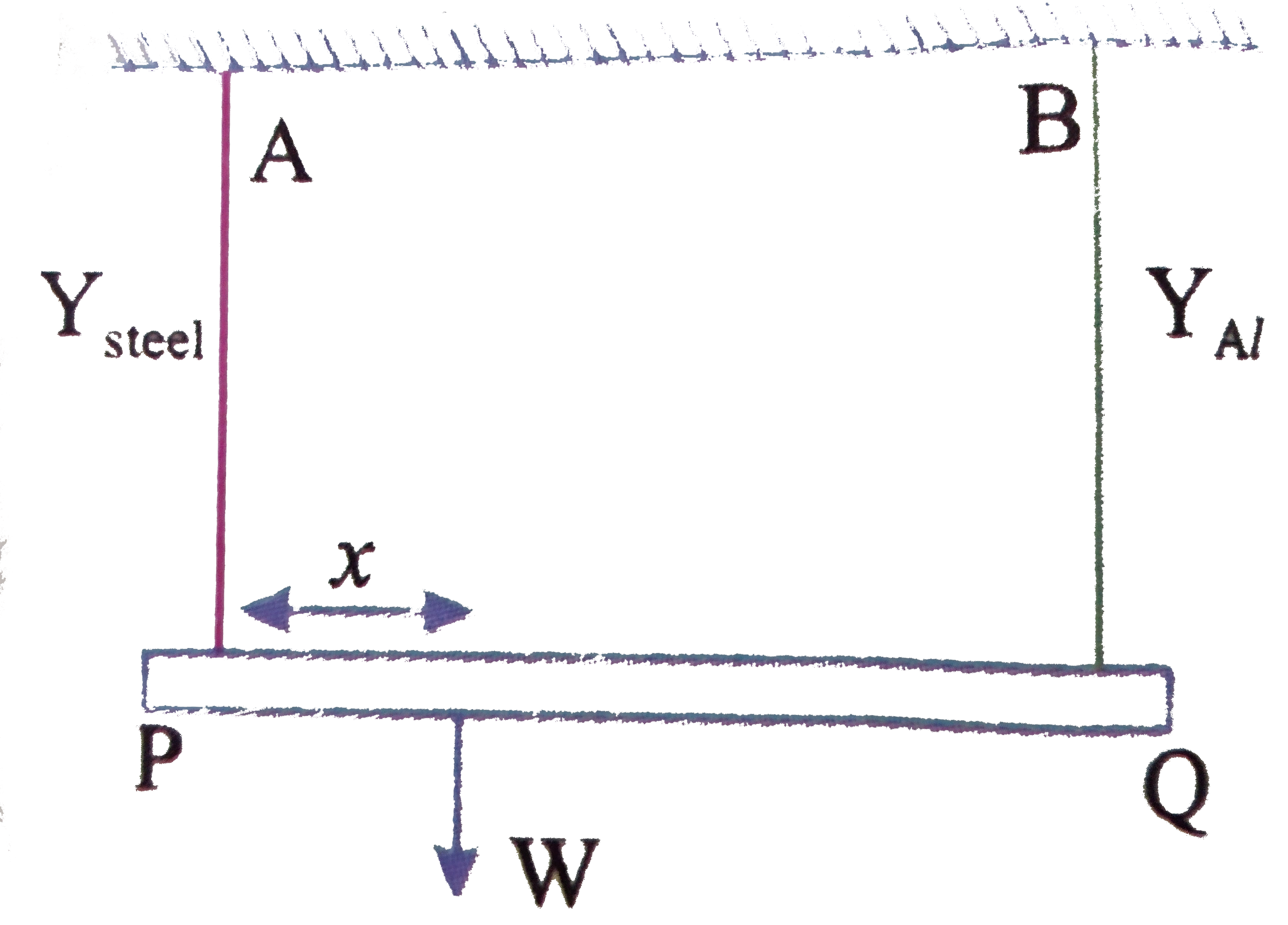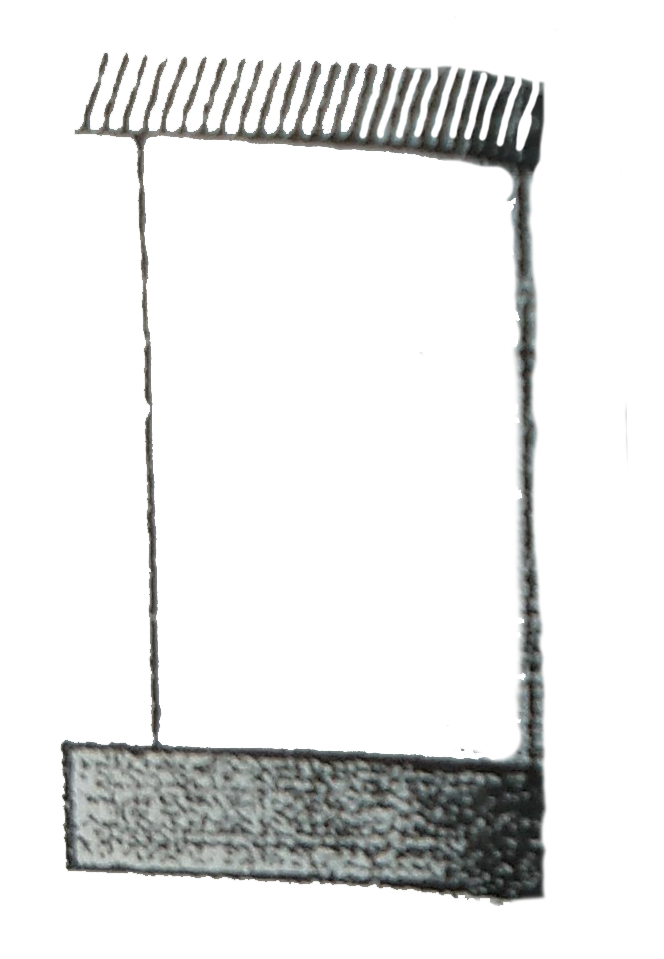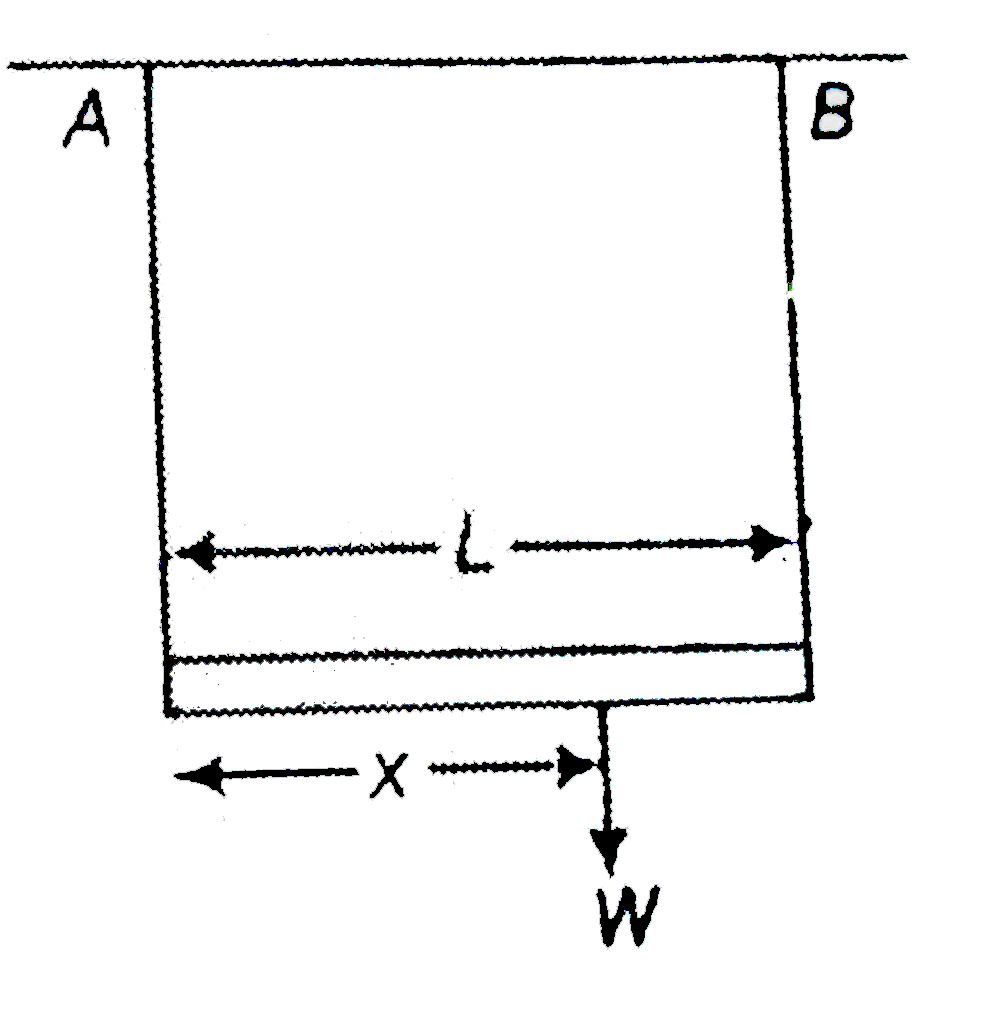A rod of length 1.05 m having negliaible mass is supported at its ends by two wires of steel (wire A) and aluminium (wire B) of equal lengths as shown in fig. The cross-sectional area of wire A and B are 1mm2 and 2mm2, respectively . At what point along the rod should a mass m be suspended in order to produce (a) equal stresses and (b) equal strains in both steel and aluminium wires. Given,
Ysteel=2×1011Nm−2andY−(aluminium)=7.0×1010N−2

Answer: (a) 0.7 m from the steel-wire end
(b) 0.432 m from the steel-wire end
Cross-sectional area of wire A, a1=1.0mm2=1.0×10−6m2
Cross-sectional area of wire B,a2=2.0mm2=2.0×10−6m2
Young’s modulus for steel, Y1=2×1011Nm−2
Young’s modulus for aluminium, Y2=7.0×1010Nm−2
(a) Let a small mass m be suspended to the rod at a distance y from the end where wire A is attached.
Stress in the wire= ForceArea=Fa
If the two wires have equal stresses, then:
F1a1=F2a2
Where,
F1 = Force exerted on the steel wire
F2 = Force exerted on the aluminum wire
F1F2=a1a2=12 ...(i)
The situation is shown in the following figure.

Taking torque about the point of suspension, we have:
F1y=F2(1.05−y)
F1F2=(1.05−y)y ...(ii)
Using equations (i) and (ii), we can write:
(1.05−y)y=12
2(1.05−y)=y
2.1−2y=y
3y=2.1
∴y=0.7m
In order to produce an equal stress in the two wires, the mass should be suspended at a distance of 0.7 m from the end where wire A is attached.
(b) Young's modulus = StressStrain
Strain = StressYoung's modulus=FaY
If the strain in the two wires is equal, then:
F1a1Y1=F2a2Y2
F1F2=a1a2Y1Y2=12×2×10117×1010=107 ...(iii)
Taking torque about the point where mass m, is suspended at a distance y1 from the side where wire A attached, we get:
F1F2=(1.05−y1)y1 ...(iii)
Using equations (iii) and (iv), we get:
(1.05−y1)y1=107
7(1.05−y1)=10y1
17y1=7.35
∴y1=0.432 m
In order to produce an equal strain in the two wires, the mass should be suspended at a distance of 0.432 m from the end where wire A is attached.
Topper's Solved these Questions
- BOOK - NCERTCHAPTER - MECHANICAL PROPERTIES OF SOLIDSEXERCISE - EXERCISE21videos
MECHANICAL PROPERTIES OF SOLIDS
- BOOK - NCERTCHAPTER - MECHANICAL PROPERTIES OF FLUIDSEXERCISE - EXERCISE31videos
MECHANICAL PROPERTIES OF FLUIDS
- BOOK - NCERTCHAPTER - MOTION IN A PLANE EXERCISE - EXERCISE32videos
MOTION IN A PLANE
Similar Questions
A rod PQ of length 1.05m having negligible mass is supported at its ends by two wires one of stell (wire A), and the other of aluminium (wire B) of equal lengths as shown in fig. The cross-sectional areas of wires A and B are 1.0mm2 and 2.0mm2 respectively. At what point along the rod a load W be suspended in order to produce
(a) equal stress, (b) equal strains in both steel an aluminium.
(Ysteel=200GPa,Yaluminium=70GPa)
 View Solution
View SolutionA point mass m is suspended usin two wires of different material as shown in the figure. If corss-section of wire-1 and sore-2 are 3mm2and√3mm2 respectively, which of the following is correct?
 View Solution
View Solution
Knowledge Check
- Question 1 - Select One or More
A rod of length 1.05 m having negliaible mass is supported at its ends by two wires of steel (wire A) and aluminium (wire B) of equal lengths as shown in fig. The cross-sectional area of wire A and B are 1mm2 and 2mm2, respectively . At what point along the rod should a mass m be suspended in order to produce (a) equal stresses and (b) equal strains in both steel and aluminium wires. Given,
Ysteel=2×1011Nm−2andY−(aluminium)=7.0×1010N−2
 AMass m should be suspended close to wire A to have equal stresses in both the wires.BMass m should be suspended close to B to have equal stresses in both the wires.CMass m should be suspended at the middle of the wires to have equal stresses in both the wires.DMass m should be suspended close to wire A to have equal strain on both wires.
AMass m should be suspended close to wire A to have equal stresses in both the wires.BMass m should be suspended close to B to have equal stresses in both the wires.CMass m should be suspended at the middle of the wires to have equal stresses in both the wires.DMass m should be suspended close to wire A to have equal strain on both wires. - Question 2 - Select One
A light rod of length L is suspended from a support horizonatlly by means of two vertical wires A and B of equal lengths as show in the figure . Cross-section area of A is half that of B and Young's modulus of A is double than that
A20m/sB25m/sC22m/sD18m/s - Question 3 - Select One
Two wires of equal length and cross-sectional area are suspended as shown in figure. Their Young's modullare Y1 andY2 respectively. The equivalent Young's modulil will bebr>
 AY1+Y2BY1+Y22CY1Y2Y1+Y2D√Y1Y2
AY1+Y2BY1+Y22CY1Y2Y1+Y2D√Y1Y2
Alight rod of length 2 m is suspended horizontlly from the ceiling bty means of two vertical wirs of equal length tied to its ends One wire is mode of steel and is of cross - section 0.1 sq cm and the other is of brass of cross -section 0.2 sq cm Find the postion along the rod at which a wight may be hung to produce (i) equal stress in both wirs (ii) equal strain in both wires (Y for brass =10×1010Nm−2andYfor steel=20×1010Nm−2)
View SolutionA light rod of length 4.0 m is suspended from the ceiling horizontally by means of two vertical wire of equal length tied to its ends. One of the wires is made of steel and is of cross-section 10−3m2 and the other is of brass of cross-section 2×10−3m2. Find out the position along the rod at which a weight may be hung to produce equal stresses in both wires.
View SolutionA wire of length 1m is stretched by a force of 10N. The area of cross-section of the wire is 2×10–6m2 and Y is 2×1011N/m2 . Increase in length of the wire will be -
View SolutionTwo wires of equal length and cross-section area suspended as shown in figure. Their Young's modulus are Y1 and Y2 respectively. The equavalent Young's modulus will be
 View Solution
View SolutionA light rod of length L is suspended from a support horizonatlly by means of two vertical wires A and B of equal lengths as show in the figure . Cross-section area of A is half that of B and Young's modulus of A is double than that of B. A weight W is hung on the rod as shown. The value of x, so that the stress In A is same as that in B,is
 View Solution
View Solution

